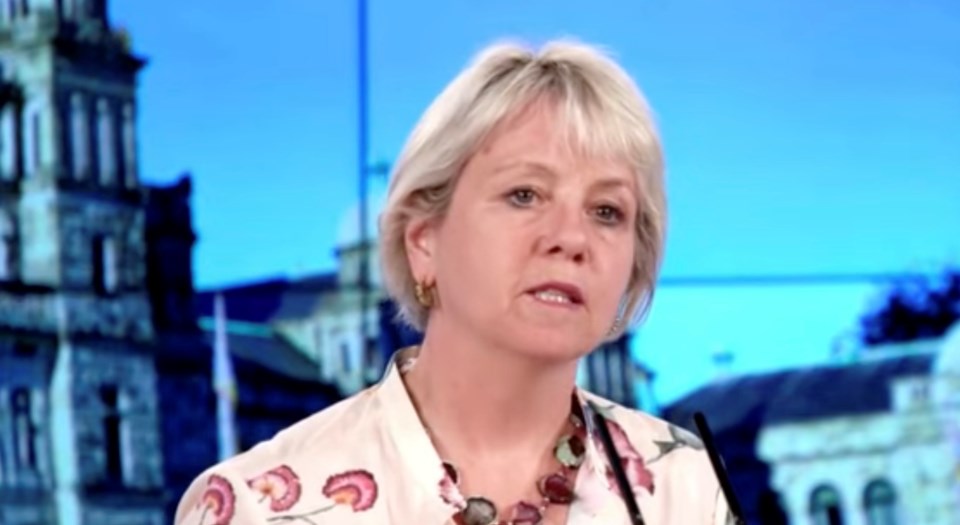Surging numbers of new COVID-19 infections has pushed up the number of those actively battling the disease to 3,834 – a level not seen since May 24, more than 11 weeks ago.
Active infections are up 85%, compared with one week ago, and are up by more than five times, from the 658 active infections one month ago.
With 513 new infections, today was the second consecutive day when the province reported that its health officials had detected more than 500 new cases in a 24-hour period. Before yesterday, the last time that happened was more than 12 weeks ago, on May 19.
Most new, and active, infections are concentrated in the Interior Health region.
Here is a breakdown of where the 513 new COVID-19 infections are in B.C.:
• 108 in Fraser Health (21%);
• 92 in Vancouver Coastal Health (17.9%);
• 271 in Interior Health (52.8%);
• 13 in Northern Health (2.5%); and
• 29 in Island Health (5.7%).
The 3,834 active infections, include:
• 750 in Fraser Health (19.6%);
• 539 in Vancouver Coastal Health (14%);
• 2,199 in Interior Health (57.4%);
• 116 in Northern Health (3%);
• 220 in Island Health (5.7%); and
• 10 people who normally reside outside B.C.
While the vast majority of those actively fighting infections are self-isolating at home, 81 are in B.C. hospitals, with 33 of those sick enough to be in intensive care units (ICUs). The last time more B.C. hospital patients were fighting the disease was on July 7, when there were 86.
With one additional death, B.C.'s death toll from the pandemic has risen to 1,779.
More than 96.3%, or 148,702, of the 154,362 people known to have contracted COVID-19 in B.C. are considered by the province to have recovered because they have gone 10 days after first feeling symptoms, and are therefore not thought to be infectious.
The pace of B.C.'s vaccination campaign has slowed, as most eligible residents are now fully vaccinated.
British Columbians received 26,977 new doses of vaccine in the past day, with 4,829 of those being first doses, and 22,148 being needed second doses.
Of the 3,814,635 B.C. residents who have received at least one dose of vaccine, 87%, or 3,318,751, are fully vaccinated.
The B.C. government estimated in February that the province's total population is 5,147,712, so that means that slightly more than 74.1% of B.C.'s total population has had at least one dose of vaccine, and more than 64.5% of the province's total population has had two doses.
The government's math holds that 82.3% of the province's eligible population, aged 12 years and older, has been vaccinated at least once, with 71.6% of eligible people being fully vaccinated.
Unvaccinated people are the ones spreading the virus
Provincial health officer Dr. Bonnie Henry and Health Minister Adrian Dix on Aug. 12 said unvaccinated people are responsible for most spreading of the SARS-C0V-2 virus, which causes COVID-19.
Because this is true not only in the community, but in seniors' homes, Henry announced that she would invoke a public health order to mandate that all workers in seniors' homes be fully vaccinated by Oct. 12.
She and Dix said they do not know exactly how many staff in seniors' homes are unvaccinated because so far there has not been an order that those facilities' workers prove their status to employers. Dix said the government was on a "strong footing" legally, although legal action may come to challenge the government's ability to require private information, and vaccination as a requirement to keep a job.
Henry said B.C.'s privacy commissioner, Michael McEvoy, told her he believed the health order was "a proportional and reasonable response," to the health crisis, and therefore would withstand legal challenges.
"We now have eight outbreaks [in seniors' homes] introduced by unvaccinated people," she said. "We've seen transmission from unvaccinated staff."
Those outbreaks include:
• Evergreen Baptist Care Society in White Rock;
• Holyrood Manor in Maple Ridge; and
• KinVillage West Court in South Delta;
• Discovery Harbour in Campbell River;
• Kootenay Street Village in Cranbrook;
• Cottonwoods Care Centre in Kelowna;
• Brookhaven Care Centre in West Kelowna;
• Nelson Jubilee Manor in Nelson.
The health order requiring staff vaccinations does not yet include those who work in hospitals, and other healthcare settings, although that could be on the horizon, Henry said.
"We are looking at other high risk settings, like other healthcare settings," she said.
The order is not yet in place in hospitals because, "the level of risk is different in an acute care setting versus the communal-living setting, like long-term care."
The B.C. government has never provided immediate breakdowns of how many new infections are in people who are unvaccinated. Instead, it provides this data weeks, and sometimes more than a month, later.
Its most recent monthly statistics were for June 15 through July 15. That data show that of the 1,777 cases detected in that time frame, 1,210, or 68.1%, were in people who were either unvaccinated, or who had had their first vaccine dose within three weeks of first exhibiting symptoms.
Another 499 people, or 28.1%, had either received one dose of vaccine, or had not yet gone one week after having received a second dose. Only 68 cases, or 3.8% of those infections, were in people who had received two doses of vaccine and gone one week after that needed second dose before symptoms first started.
Within the June 15 through July 15 timeframe, only 4.5%, or eight of 176 people in hospital with COVID-19, had been fully vaccinated for more than seven days when symptoms first appeared. One of the 21 deaths in that time period, or 4.8%, were in people who had been fully vaccinated for more than seven days before symptoms first appeared.
On August 12, Henry said she believes more recent data show that fully vaccinated people continue to comprise a similarly small fraction of overall new infections.



